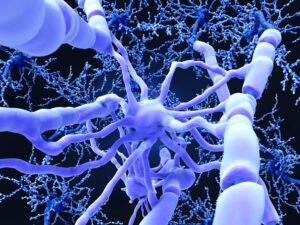A New Perspective on Lysosomal Lipid Homeostasis in NPC1 Disease
While cholesterol accumulation remains central to Niemann-Pick type C1 (NPC1) pathophysiology, recent research has expanded our understanding of the complex lipid metabolic disruptions driving disease progression. A significant addition to this evolving picture comes from Nyame et al.’s recent Nature publication, which identifies PLA2G15 as a lysosomal bis(monoacylglycero)phosphate (BMP) hydrolase and demonstrates that targeting this enzyme can ameliorate NPC1 pathology.
This discovery highlights how addressing multiple pathogenic pathways could offer new therapeutic opportunities for NPC1 and related lysosomal storage disorders.
Defining PLA2G15’s Role in Lysosomal Phospholipid Metabolism
The breakthrough centers on PLA2G15, a lysosomal phospholipase A2 whose substrate specificity had remained unclear. Through comprehensive biochemical analysis, the authors demonstrate that PLA2G15 specifically hydrolyzes BMP, a unique phospholipid that is mainly found in late endosomes where it accounts for ∼15 % of the total membrane composition.
BMP plays crucial roles in membrane organization, protein sorting, and vesicle fusion within lysosomes. While BMP accumulation occurs in various lysosomal storage disorders, the pathophysiological significance and responsible catabolic enzymes had remained elusive. This identification of PLA2G15 as the key BMP hydrolase provides critical insight into how disrupted phospholipid turnover contributes to lysosomal dysfunction.
Therapeutic Validation in NPC1 Disease Mouse Models
To test PLA2G15’s therapeutic potential, researchers generated NPC1-/-Pla2g15-/- double mutant mice using the established NPC1-/- model. The in vivo studies, conducted at Scantox Neuro, revealed remarkable disease amelioration across multiple endpoints despite continued cholesterol accumulation.
Key therapeutic effects included substantial preservation of cerebellar Purkinje cells, reduced neuroinflammation measured by decreased GFAP immunoreactivity, and improved motor coordination with extended survival which are all pathological hallmarks of NPC1 disease. Particularly noteworthy was the reduction in cerebrospinal fluid neurofilament light chain (NfL), an established biomarker of axonal damage with growing clinical relevance.
These findings establish that BMP metabolism represents a distinct pathogenic pathway that can be therapeutically targeted.
Mechanistic Insights and Therapeutic Implications
The therapeutic mechanism likely involves restoring lysosomal membrane homeostasis through BMP level modulation. BMP’s unique structural features influence membrane properties and protein-lipid interactions critical for lysosomal function. By preventing excessive BMP degradation, PLA2G15 deletion appears to maintain more physiological membrane composition.
Translating these findings to human therapeutics presents challenges, including the need for selective PLA2G15 modulators with appropriate CNS penetration and the requirement to carefully balance therapeutic benefit with physiological lysosomal function.
Broader Impact and Future Directions
The PLA2G15-BMP axis extends beyond NPC1 to other lysosomal storage disorders characterized by BMP accumulation, potentially supporting therapeutic development across multiple rare as well as neurodegenerative diseases. The availability of CSF NfL as a translational biomarker provides a valuable bridge for clinical development, offering early assessment of therapeutic effects.
This work exemplifies how collaborative research infrastructure — Including Scantox’s specialized NPC1-/- modeling platform — enables comprehensive validation of novel therapeutic targets. Moving forward, detailed structure-function studies, clinical validation of BMP metabolism alterations in patients, and exploration of combination therapy approaches represent promising research directions.
The identification of PLA2G15 as a BMP hydrolase not only opens new therapeutic avenues for NPC1 but also enhances our fundamental understanding of lysosomal phospholipid homeostasis, with implications extending to neurodegeneration more broadly.
This study utilized the NPC1-/- mouse model available through Scantox Neuro’s rare disease research platform. For study design information contact office-austria@scantox.com.
Reference
Nyame, K,, et al. PLA2G15 is a bis(monoacylglycero)phosphate hydrolase and its targeting ameliorates lysosomal disease. Nature. 2025; doi: 10.1038/s41586-025-08942-y











